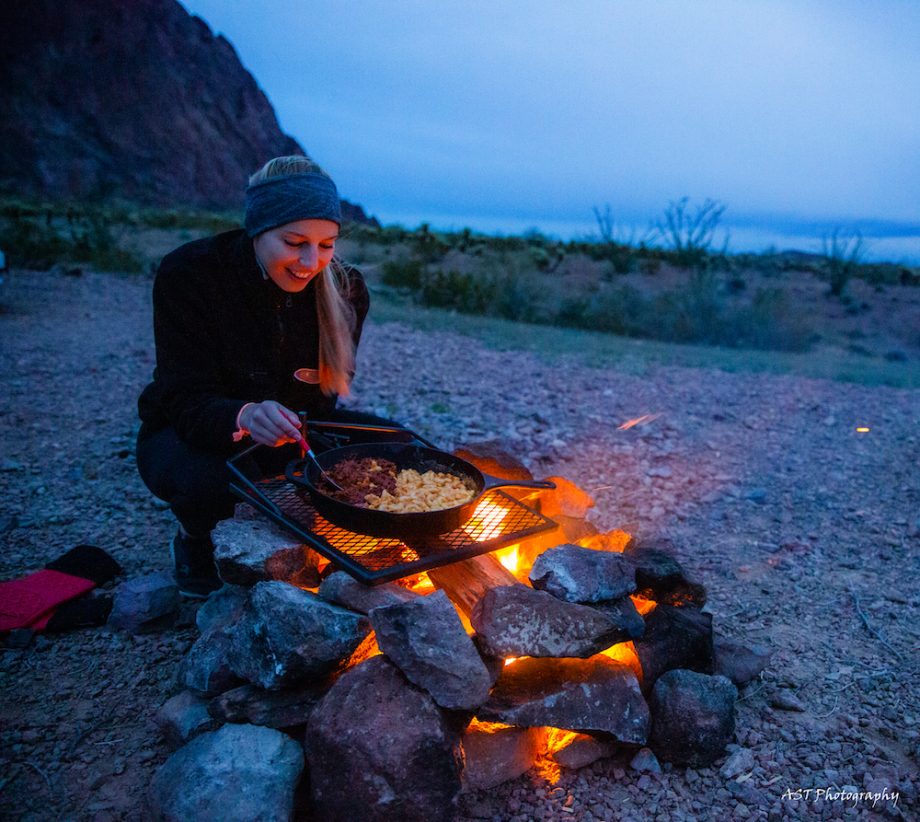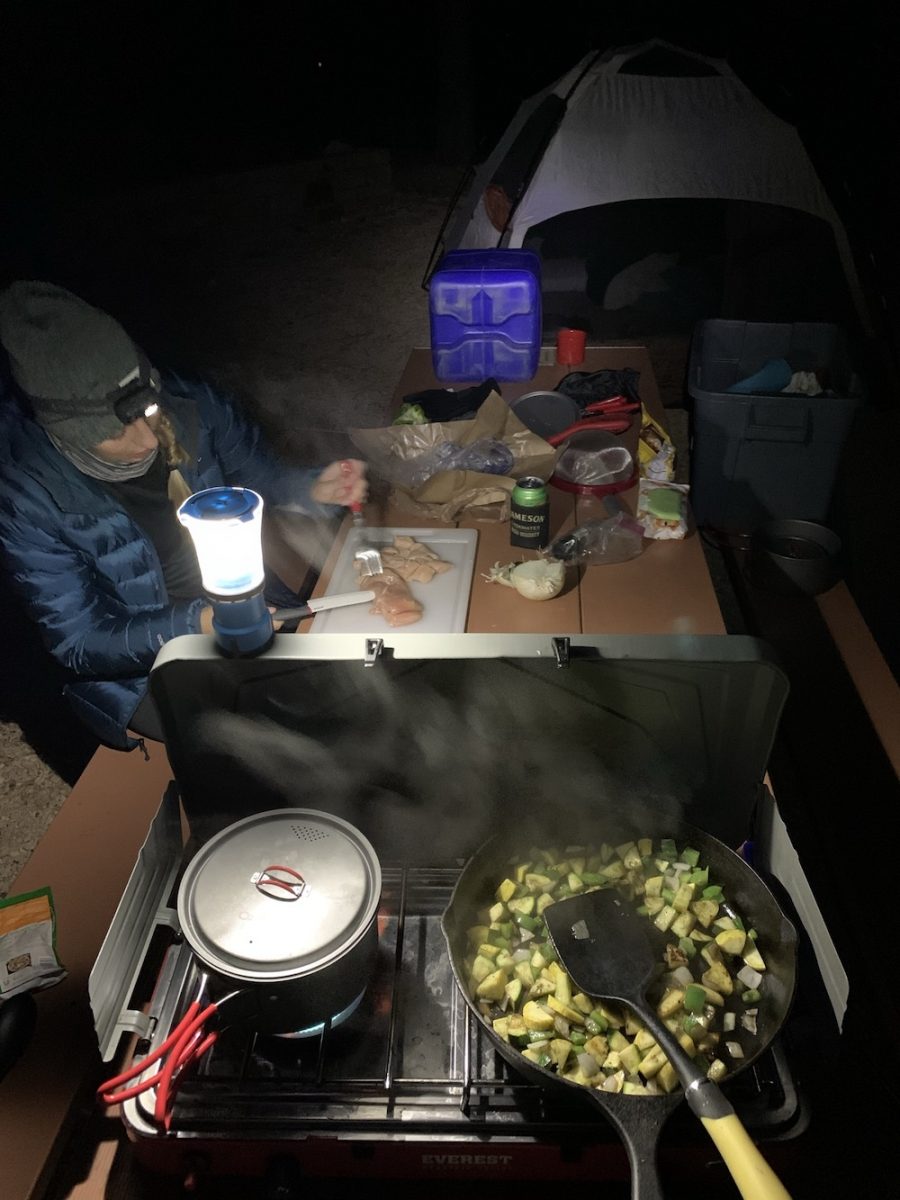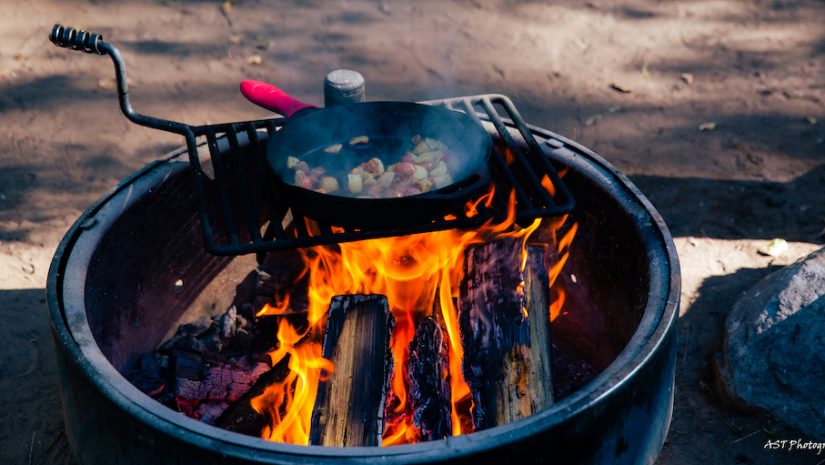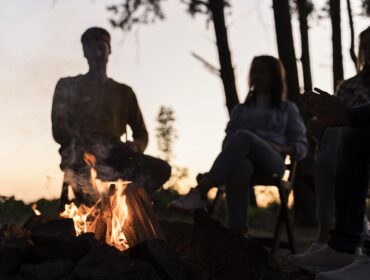You walk into the grocery store. You look around. All of a sudden, a wave of anxiety fills you. What am I going to cook during the camping trip? How am I going to cook? It’s a feeling that many have experienced. However, you don’t need to feel anxious. Cooking in the wild can be just like doing it at home — just with better scenery! Let’s dive into easy camp meal options, how to cook, and the right cooking gear to choose. By the end, you’ll feel like a pro as you head into nature and your next adventure.
How to cook and gear options
There are two ways to cook in while camping: on a stove or over an open flame. The former is easier and safer, while the latter is more rugged, natural, and potentially dangerous. We’re going to mostly talk about using a camp stove. This is because fire regulations are very strict and open flames are typically discouraged, but I will touch on using an open flame fire toward the end of the article.
In addition to your source of flame, you’ll need the appropriate cooking gear. Make sure to have a pot and frying pan, utensils, spatulas, cutting board, and oven mitts. You can learn more about how to assemble a kitchen camping box here, which will have everything you need to cook in the wild.
With a camp stove, it’s almost like cooking at home. Most stoves have an internal lighter which means you only need to turn on the propane and click the sparking button. Most stoves come with two burners, although there are some with only one. I prefer the two for cooking multiple items at once. Once your flame is alive, cook away. I recommend keeping an eye on the flame height. Make sure no oil or grease splashes onto the flames.

When it comes to cooking with an open flame, this is almost completely banned in the western United Stated except in campgrounds. In a lot of cases, campgrounds have even banned fires as well. However, if it is allowed, you can go two ways. The first is to cook on top of a metal rack that will hold your pots and pans. This is a more conventional route. When you do this, keep in mind your equipment will get very hot. It’s crucial to make sure you’re using gear that won’t melt — think cast iron skillets.
The second route is to wrap your food in tin foil and cook with the heat of the embers. This is a bit more time-consuming, yet you can get creative with what you make. Normally, baked potatoes would be great but I’ve also seen surf n’ turf, nachos, and cinnamon apples. The world is your oyster when it comes to using this method. Just remember to be fire safe and follow local rules!
Easy foods to cook at the campsite
When it comes to making food while camping, people usually fall into two groups. Some go all out prepping beforehand to make exquisite meals. Then, there are others who go for simplicity. While neither is wrong, I can tell you that you can make great-tasting food without much prep work. When it comes down to making easy foods, I view easy as only a few ingredients. The meal may still take a little time, but the process shouldn’t be difficult.
Here are five easy and delicious meals to make while camping:
Pesto Pasta, sausages, and spinach
Talk about quick and easy! Grab a jar of pesto, a bag of tortellini, and a pack of chicken apple sausages. This entire meal shouldn’t take more than 15 minutes to cook and clean up is effortless too. It’s the perfect camping meal!
Breakfast skillet
This is the only breakfast idea here but it’s a good one. Using your cast iron skillet, empty precut potatoes, sausage/bacon (can be precooked or uncooked — either work), peppers and onions, and cheese. Let this cook for a while. Then, towards the end, add in your eggs and mix around for a scrumptious breakfast.
Steak, mashed potatoes, and Brussels sprouts
This is the most luxurious meal of the five, but also quite easy. The hardest part will be remembering to marinate the meat before cooking. After that, throw them on your cast iron skillet and grill them until they’re cooked to your liking. You’ll likely only have two stovetops to work with, so have the Brussels sprouts going on the other stove. When the steaks are done, boil water for the mashed potatoes. The entire meal shouldn’t take more than 15 minutes.
Tacos
This is one of my favorite campground meals. it can have a few more steps due to dicing peppers and onions (and anything else you’d like), but it’s worth it. Then, cook your meat or, if you’re looking to go vegetarian, use portobello mushrooms. Lastly, don’t forget your taco seasoning, salsa, and avocado. In all, this is a meal your belly will be craving!
Burgers, potato salad, asparagus
A classic meal for the campsite. No one can say no to burgers (plant-based or regular). It’s a quick and easy execution. Just don’t forget the condiments or else the burgers may seem a bit dry!

Clean up and storage after camp cooking
Properly cleaning up and storing your food is one of the most important parts of camping — especially if you’re in an area known for bear activity. Now, this isn’t to scare you out of camping in bear territory. It’s merely a warning sign that improperly cleaning up could result in a 400-pound visitor rummaging around your site in the middle of the night. I think we can all agree that is not what we’d like to experience.
So, what’s the proper way to clean and store foods in nature?
First, when cleaning up after your meal, your goal is to leave as few remnants of food as possible for rodents or animals to find. The second is to ensure your dishes and cooking equipment are scent-free. Doing these two things will greatly diminish the likelihood of animals wandering into your campsite.
To accomplish this, make sure you’re using biodegradable soap. As environmental stewards, we must think about the impact we’re having on nature while also still being safe and smart. This achieves both.
As you’re cleaning up, make sure to get all leftovers either into the trash or into a Tupperware container. The biggest attractant to animals is chunks of food scattered around your picnic table. Keeping these as close to zero will ensure you have an animal-free experience.
When it comes to storing your food, this depends on where you are. First, your perishables should go in your cooler regardless of where you are. Your food won’t last too long if it gets warm in the midday sun. Next is where you place your food while you’re away from camp. If you’re in a high active bear zone, the campground will likely have bear lockers for you. These are a must to prevent bears from smashing your car windows and dumpster diving into your backseat. In other places, putting your food in your car will suffice to keep smaller animals away.
On the flip side, this is all moot if you’re backpacking. In the backcountry, securing your food is paramount. In bear territory, most will opt for (or be required to use) a standard bear canister. These are mandated in many national parks and wilderness areas. When you head to sleep, a good rule of thumb is to store it around 150 feet away from your tent. For those who aren’t backpacking in bear zones, a food sack that you can tie 20 feet from the ground is another way to protect your precious food. Doing this is easy — find a medium-sized rock, tie your rope around it, and throw it over a large branch above you. Once it’s over, untie the rock, tie your bag to that end, hoist it up, and tie the other end to the easiest place you can. Your bag is now unreachable by most creatures.
Taking these precautions will not only make your trip less eventful, you’re also taking necessary steps to keep wild animals safe. If they find it easy to eat people food, they will lose their natural hunting and gathering skills, making them less likely to survive in the absence of humans.
Article and Photos by Alec Sills-Trausch
Alec is a photographer, writer, and avid hiker who enjoys pushing the limits to find incredible destinations. He hopes through his work to inspire others to get outside and to respect planet earth so future generations can enjoy it just the same. He’s also a cancer survivor, hoping to use his voice to show that you can have a wonderful life after the treatment.




